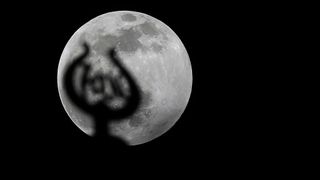
Viewers in Asia, Australia, Europe and Africa were treated to a very subtle type of eclipse Friday (Jan. 10) — a penumbral lunar eclipse that just barely darkened the moon.
The Wolf Moon passed through the faint outer shadow of the Earth, which is called the penumbra, and made the moon's usual black, gray and white tones take on a tea-stained color. The eclipse took place over four hours starting at 12:07 p.m. EST (1707 GMT), with maximum eclipse occurring at 2:10 p.m. EST (1910 GMT).
"You can see this isn't an evenly illuminated full moon, but it's getting more and more difficult to see now," said Slooh astronomer Paul Cox around 3:30 p.m. EST (2030 GMT), during a live astronomy broadcast as the eclipse was nearing its last phases.
Related: Lunar Eclipse 2020 Guide: When, Where & How to See Them

Cox pointed out the penumbral eclipse to viewers using a live telescope view of the moon, from the Canary Islands. "Down at the bottom right hand corner, about the 4:00 or 5:00 position, you can see it's just darker," he explained. "[The shadow] is not like the dark seas up above, but there is a slight shade, and there is a slight curvature to it."
A penumbral eclipse happens due to a slight misalignment between sun, moon and Earth. This type of eclipse needs two key ingredients: for the moon to be at the full moon phase (which it reached at 2:21 p.m. EST, or 1921 GMT) and for the three celestial bodies to come close to aligning — close enough for the moon to pass through the outer region of Earth's shadow, but not the central part of the shadow.

When the three bodies are more tightly aligned, more spectacular eclipses happen. Partial lunar eclipses occur when the moon passes into the deeper part of the Earth's shadow (known as the umbra), and total lunar eclipses — also known as Blood Moons — happen when the Earth completely blocks the sun's light from reaching the moon. During total eclipses, the moon only receives refracted light from Earth, turning the surface red.

Solar eclipses, by contrast, have to do with how perfectly the moon covers the sun in the sky when it passes in between the sun and the Earth. If the moon partially crosses over the sun, a partial eclipse happens. If it perfectly aligns, a total eclipse happens — but only for a few minutes, until the moon's orbit moves it past the sun. (Always use proper safety equipment to view a solar eclipse.)

If you missed this penumbral eclipse, you can catch three more opportunities in 2020: June 5, July 5 and Nov. 30. The last 2020 eclipse will have the deepest darkening of the trio. All four lunar eclipses in 2020 are of the penumbral variety; the next total lunar eclipse isn't until May 26, 2021. Check out our lunar eclipse viewing guide to check if your location will experience the eclipse. If not, you can always catch the show online at Space.com.
Follow Elizabeth Howell on Twitter @howellspace. Follow us on Twitter @Spacedotcom and on Facebook.

Science - Latest - Google News
January 11, 2020 at 06:01AM
https://ift.tt/2NeXd5y
Wolf Moon lunar eclipse kicks off penumbral quartet for 2020 (photos) - Space.com
Science - Latest - Google News
https://ift.tt/2Kb7H4e
Shoes Man Tutorial
Pos News Update
Meme Update
Korean Entertainment News
Japan News Update
Bagikan Berita Ini
















0 Response to "Wolf Moon lunar eclipse kicks off penumbral quartet for 2020 (photos) - Space.com"
Post a Comment